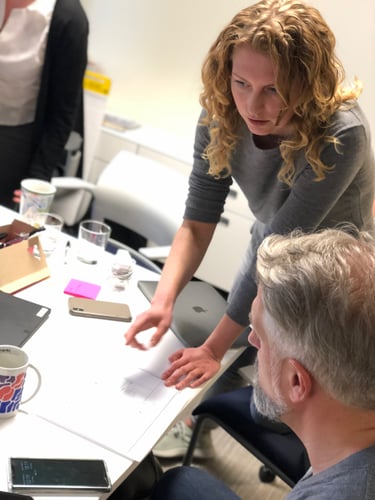InnovationCamp BW Silicon Valley offers SMEs from Baden-Wuerttemberg the opportunity to discover the spirit and methods of the world's most innovative location. As Innovation Scout for the State of Baden-Wuerttemberg in Silicon Valley, Annika Hoeltje manages the local activities. We met her for an interview. In the first part, she explains the goals of InnovationCamp BW and discusses the success factors of Silicon Valley.
Silicon Valley blog series
- Part 1: If you don't ask, you will never know
- Part 2: Chasing the unicorn
- Part 3: “Be a sponge and not a babbler:” Interview with Annika Hoeltje (1)
- Part 4: “Be a sponge and not a babbler:” Interview with Annika Hoeltje (2)
- Part 5: A special mindset
- Part 6: Properly set up for success
- Part 7: Lunch and Learn - Bites of knowledge
- Part 8: “The gold diggers from back then are the founders of today” – Interview with Oliver Donner and Loren Heilig (1)
- Part 9: “The gold diggers from back then are the founders of today” – Interview with Oliver Donner and Loren Heilig (2)
What tasks do you have as an Innovation Scout for the State of Baden-Wuerttemberg in Silicon Valley?
Annika Hoeltje: On the one hand, I am on the lookout for new digital technologies and business models that are emerging in Silicon Valley and I looking for opportunities and challenges for companies in Baden-Wuerttemberg. In addition, I examine the extent to which innovation methods that have been successfully tested in Silicon Valley are relevant for Baden-Wuerttemberg. I present my findings on the InnovationCamp Blog and at various events.
On the other hand, I organize InnovationCamp BW in Silicon Valley. The principle: bring Baden-Wuerttemberg SMEs to Silicon Valley for three weeks to work on specific issues with regard to digitalization and new business models and products. Once here, they are supported by our InnovationCamp team as well as well-known experts and mentors. These can be start-ups, local venture capitalists, or university professors. The aim is to anchor the methods used in Silicon Valley in Baden-Wuerttemberg's economy and make new technologies available to the State.
What are the goals of InnovationCamp BW Silicon Valley?
Annika Hoeltje: Participants can learn successful innovation methods, try them out, and test whether they might apply to their own companies. We give them a different view of their own businesses in the globalized and digitalized world. Do I have to reposition myself to be successful in the long run? Which innovative products and services can complement my portfolio?
At the same time, we provide participants with the tools they need to validate their ideas in terms of their needs and feasibility. How do I properly interview potential customers? How do I create a minimal viable product, a product that initially only meets the minimum requirements to test the most important customer value hypotheses? How do I know if my idea will fit the product market? With the right techniques, participants will find answers to these questions.
The InnovationCamp is also a platform for networking. We organize appointments in advance with potential customers, business, and technology partners in Silicon Valley. This way, the participants get in contact with proven industry experts and can use what they learn in their own businesses.
What is your assessment of the previous editions of InnovationCamp?
Annika Hoeltje: Since its launch in 2018, we've done the program four times already. The feedback from the participants is extremely positive. Some companies have even participated a second time, either sending other team members or coming back themselves for another round. In particular, many CEOs appreciate that they can step away from their day-to-day work and spend two to three weeks working hard on what their company will look like in ten years' time. Because one thing is clear: to develop out-of-the-box ideas, you really have to get out of the box.
What fascinates you personally about Silicon Valley?
Annika Hoeltje: I find people's drive, the enthusiasm, and the joy in experimentation impressive. They are fired up for their vision and work purposefully towards it. For new developments, they see opportunities rather than risks. The people are very communicative, curious, and like to exchange ideas. Working with such people is a lot of fun. I also appreciate the tremendous interculturality: the brightest minds from around the world come together in Silicon Valley to realize their visions together.
What is the special Silicon Valley mindset?
Annika Hoeltje: I like to summarize it like this: learning, sharing, doing. Learning means that people are eager to learn and fully focused on learning as much as possible about their customers' issues. Sharing asks how can I solve these problems not on my own, but together with others. Networking plays an important role here. There is an intensive exchange with start-ups, companies, universities, and other partners in order to get assessments from different angles. Doing means that ideas are implemented quickly just to try things out. Since testing is done on a small scale, the risk is usually limited.
What is the formula for the success of Silicon Valley's companies?
Annika Hoeltje: In addition to the radical focus on customer value, the speed with which ideas are implemented plays a key role. People are open to new things. At the beginning, most Americans have only one vision and one prototype to test and develop. If something does not work, they pivot and change direction. They keep on doing this, groping their way along to make their vision a reality. The Germans, on the other hand, brood over a plan for a long time, until they turn to the customers. They often search in advance for reasons why something won't work.
Failure is considered a negative in Germany. In Silicon Valley, people are aware that nine out of ten ideas will flop. Although the probability of success is low, they try anyway. They limit the risk of failure by talking to as many potential customers as possible before investing money in development, marketing, and sales. An American mentor at the InnovationCamp always shares this motto: “Be a sponge and not a babbler.” What he means is that you don't talk to customers to present your own product; instead, you're there to hear about users' concerns. Absorb as much information as possible while sharing as little as possible about yourself will increase the chance of a product fitting the market. In the end, customers should get exactly the product they need.
![IBacademy_Logo_blau[496] IBacademy_Logo_blau[496]](https://www.ibsolution.com/hs-fs/hubfs/IBacademy_Logo_blau%5B496%5D.jpg?width=200&name=IBacademy_Logo_blau%5B496%5D.jpg)




